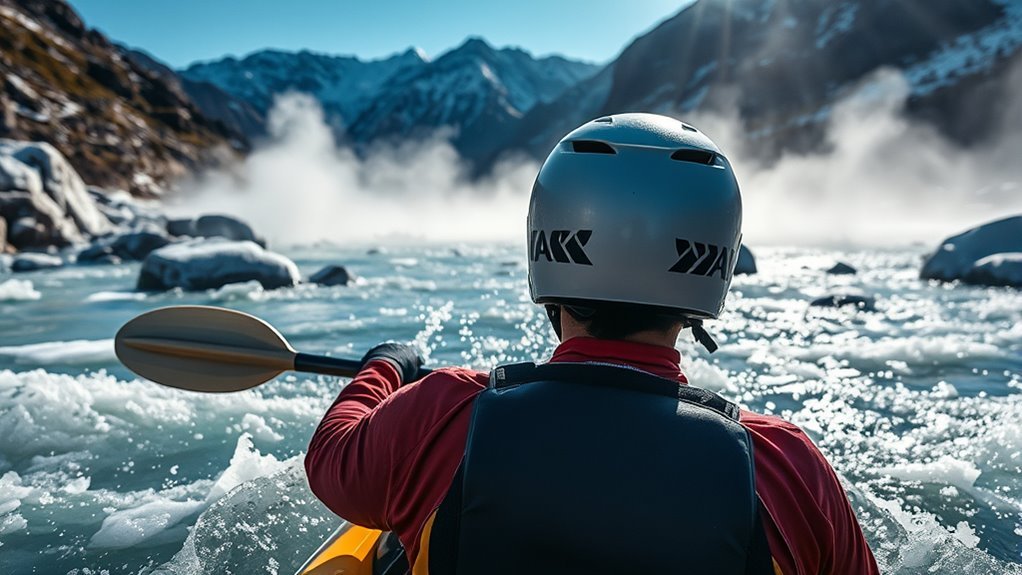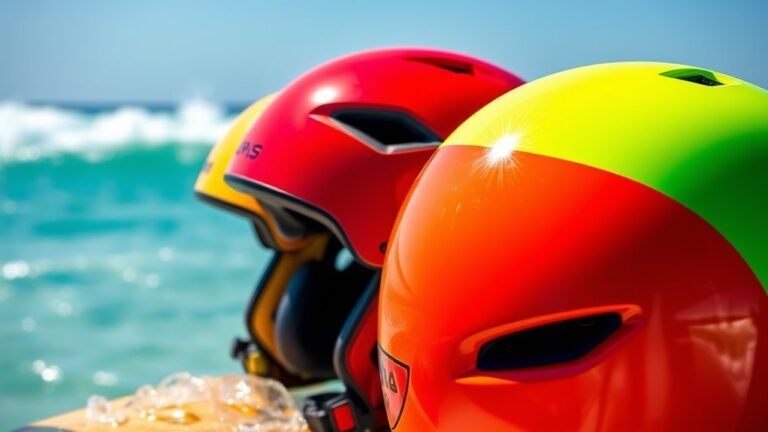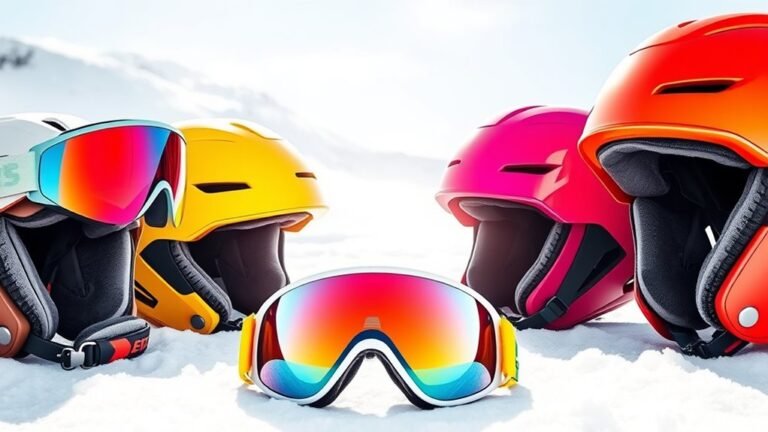How Water Helmets Protect Against Cold Water Injuries
Water helmets protect you against cold water injuries by providing essential insulation and impact protection. Their quality materials, like neoprene, help maintain your body temperature, reducing hypothermia risk during aquatic activities. The rigid outer shell absorbs shock, minimizing injury from falls or collisions. A secure and comfortable fit guarantees that the helmet stays in place, allowing you to focus on your activity. Learn more about the features that make water helmets a vital part of your safety gear.
Understanding Cold Water Injuries
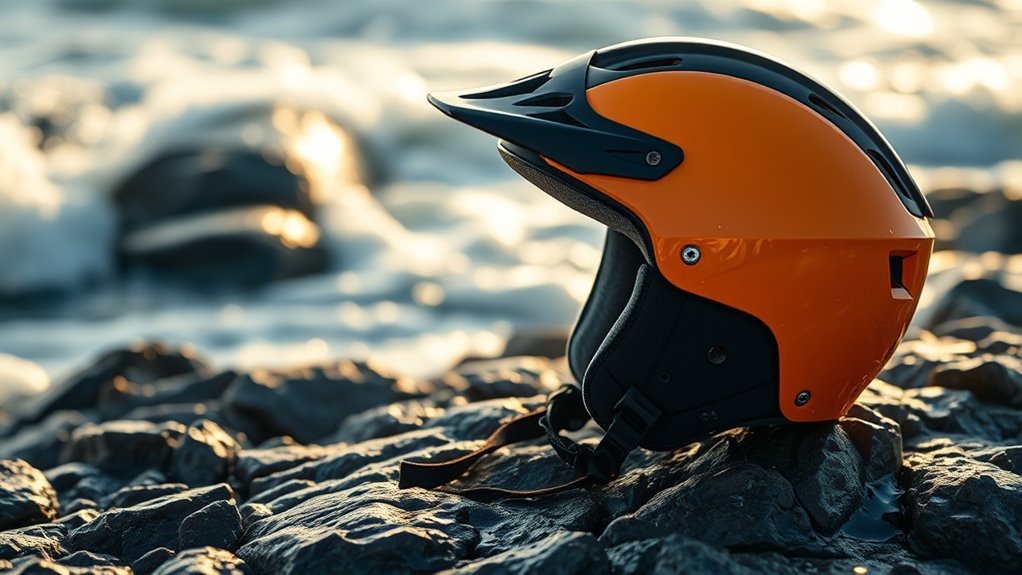
When you find yourself in cold water, it’s crucial to understand the risks associated with hypothermia and other cold water injuries. Cold shock can hit you within seconds of immersion, causing gasping, rapid heart rate, and disorientation. This initial response can lead to panic, increasing the danger of drowning. As time progresses, the hypothermia risk escalates; your body loses heat faster than it can generate it. Symptoms like shivering, confusion, and fatigue indicate your core temperature is dropping. Awareness of these dangers empowers you to take preventive measures, such as wearing appropriate gear. Staying informed helps you embrace the freedom of water activities while minimizing risks. Remember, understanding these injuries is the first step toward enjoying cold water safely.
The Role of Insulation in Water Helmets

Cold water injuries can escalate quickly, making protective gear a significant part of your safety strategy. Insulation in water helmets plays an essential role in maintaining your body temperature when you’re exposed to frigid conditions. The effectiveness of these helmets largely depends on the quality of insulation materials used. High-performance insulation materials, such as neoprene or specialized foams, have excellent thermal properties that help retain heat. This not only keeps you warm but also reduces the risk of hypothermia. When choosing a water helmet, consider how well the insulation can withstand cold water exposure. A well-insulated helmet can provide you with the freedom to enjoy your aquatic adventures while ensuring your safety against cold water injuries.
Impact Protection Features of Water Helmets
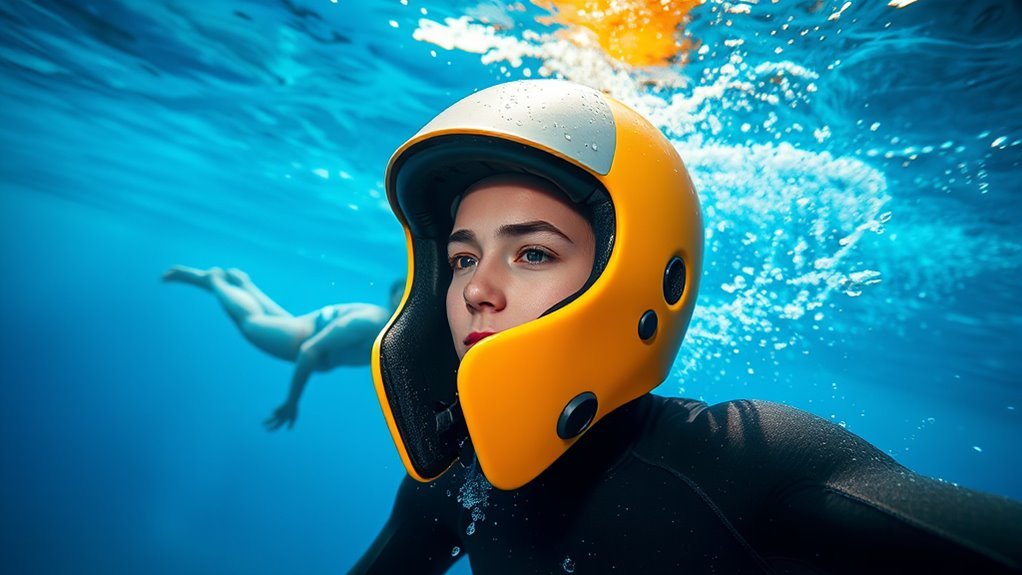
While enjoying water sports, you shouldn’t overlook the importance of impact protection features in water helmets. These helmets are designed with advanced materials that guarantee maximum impact absorption, safeguarding your head during unexpected falls or collisions. The outer shell often includes a rigid layer that enhances shock resistance, effectively dissipating energy away from your skull. Inside, cushioned liners further enhance this protective capability, providing a snug fit that minimizes movement during impacts. When selecting a water helmet, look for certifications that indicate superior impact protection standards. Remember, your freedom to explore water sports hinges on your safety, so investing in a quality helmet with robust impact features is vital for your protection and enjoyment.
Benefits of Wearing a Water Helmet
Wearing a water helmet offers numerous benefits that enhance your safety and enjoyment during water sports. One of the key water helmet benefits is cold water protection, which helps to regulate your body temperature and prevent hypothermia in chilly conditions. By insulating your head, a helmet not only keeps you warm but also reduces the risk of heat loss, allowing you to stay focused on your activity. Additionally, a helmet provides vital impact protection against unexpected falls or collisions, giving you the freedom to push your limits without fear. With a secure fit and lightweight design, you can enjoy your time on the water, knowing you’re taking essential steps to safeguard your health and overall experience.
Choosing the Right Water Helmet for Your Needs
When selecting a water helmet, you’ll want to prioritize fit and comfort to make certain it stays secure during use. Additionally, consider safety ratings and standards to confirm adequate protection, along with the helmet’s material and insulation options for ideal warmth. Making these informed choices can greatly enhance your safety in cold water situations.
Helmet Fit and Comfort
Choosing the right water helmet is essential for ensuring both safety and comfort during your aquatic adventures. Proper helmet sizing is vital, as an ill-fitting helmet can lead to discomfort and decreased protection. When selecting a helmet, consider these comfort factors:
- Adjustable straps for personalized fit
- Weight of the helmet for ease of use
- Padding and lining for added comfort
- Ventilation designs to prevent overheating
- Style and aesthetics that resonate with your personality
Safety Ratings and Standards
While you might be focused on comfort and fit, understanding safety ratings and standards is vital for selecting a water helmet that effectively protects against cold water injuries. Look for safety certifications from recognized organizations, as these indicate that the helmet has passed rigorous testing protocols. These certifications guarantee the helmet meets specific impact resistance and thermal protection criteria, essential for your safety. Helmets with the highest ratings offer better assurance that they can withstand the rigors of cold water activities. Remember, a well-rated helmet not only enhances your freedom on the water but also greatly reduces the risk of injury. Prioritize safety ratings when making your choice, and you’ll be better equipped for your adventures.
Material and Insulation Options
Selecting the right materials and insulation options is key to maximizing the protective features of your water helmet. The choice of material types and insulation thickness can greatly impact your comfort and safety in cold water conditions. Consider the following factors when choosing:
- Material Types: Look for durable options like polycarbonate or fiberglass.
- Insulation Thickness: Thicker insulation offers better thermal protection.
- Weight: Lightweight materials enhance comfort without sacrificing safety.
- Water Resistance: Verify the helmet is designed to repel water effectively.
- Ventilation: A well-ventilated design helps prevent overheating during activity.
Safety Tips for Cold Water Activities
When engaging in cold water activities, it’s essential to dress appropriately for the conditions to maintain body heat. Additionally, staying aware of your environment helps you recognize potential hazards and respond effectively. These precautions can greatly reduce the risk of cold water injuries.
Dress Appropriately for Conditions
Dressing appropriately for cold water activities is essential for ensuring your safety and comfort. Using effective layering techniques can help you adapt to changing weather conditions while keeping your body warm. Here are some tips to guide your clothing choices:
- Start with a moisture-wicking base layer to keep sweat away from your skin.
- Add an insulating layer, like fleece or wool, to trap heat.
- Use a waterproof and windproof outer layer to shield yourself from elements.
- Don’t forget thermal socks and gloves to protect your extremities.
- Always wear a fitted water helmet, as it adds an extra layer of warmth and safety.
Stay Aware of Environment
Being aware of your environment is essential for staying safe during cold water activities, as conditions can change rapidly and unexpectedly. Keep an eye on weather forecasts and be mindful of seasonal changes—what feels safe one day might not be the next. Water temperatures can drop quickly, especially in the spring and fall, so always check local conditions before heading out. Look out for signs of changing weather, such as dark clouds or strong winds, which can indicate a shift in safety. Stay alert to your surroundings, including currents and potential hazards, like rocks or debris. By maintaining environmental awareness, you can enjoy your freedom in cold waters while minimizing risks and ensuring a safer experience.
Frequently Asked Questions
Can Children Wear Adult-Sized Water Helmets Safely?
Children shouldn’t wear adult-sized water helmets due to safety concerns. Helmet sizing is essential for effective protection; an ill-fitting helmet can compromise its intended function. For child safety, it’s best to use helmets specifically designed for their size and age, ensuring a snug fit that provides adequate protection. Adult helmets are often too large and heavy, which can lead to discomfort and potential injury. Always prioritize proper fitting gear for maximum safety.
How Do I Clean and Maintain My Water Helmet?
Keeping your water helmet clean is like polishing a gem; it shines brighter when well cared for. To maintain your helmet, rinse it with fresh water after each use to remove debris. For deeper cleaning, use a mild soap and a soft cloth, avoiding harsh chemicals that can damage helmet materials. Confirm it’s fully dried before storage to prevent mold. Regular maintenance will prolong its life and keep you safe on the water!
Are There Specific Brands Known for Quality Water Helmets?
Yes, there are several water helmet brands known for their quality. Look for brands like Sweet Protection, Shred Ready, and NRS, which use quality materials to guarantee safety and durability. These brands are recognized for their rigorous testing and commitment to performance, providing helmets designed to withstand challenging conditions. When choosing, consider features like fit, ventilation, and insulation to enhance your experience on the water while keeping safety a priority.
What Are the Warning Signs of a Cold Water Injury?
When you plunge into icy waters, it’s like stepping into a frozen embrace. Be alert for cold water symptoms, such as shivering, numbness, and confusion. These signs can creep up on you, signaling the need for injury prevention measures. If you start to feel disoriented or fatigued, it’s essential to get out of the water immediately. Stay vigilant, and keep your safety a priority, ensuring your adventures remain exhilarating, not perilous.
Is It Safe to Wear a Water Helmet While Swimming?
Yes, it’s generally safe to wear a water helmet while swimming, as long as you follow basic swimming precautions. Water helmet safety is essential, especially in environments with potential hazards. These helmets can provide protection against impacts, but make certain they fit properly and don’t hinder your movement or visibility. Always assess your surroundings and conditions to guarantee a safe swimming experience while using protective gear like helmets. Your safety should always come first!
